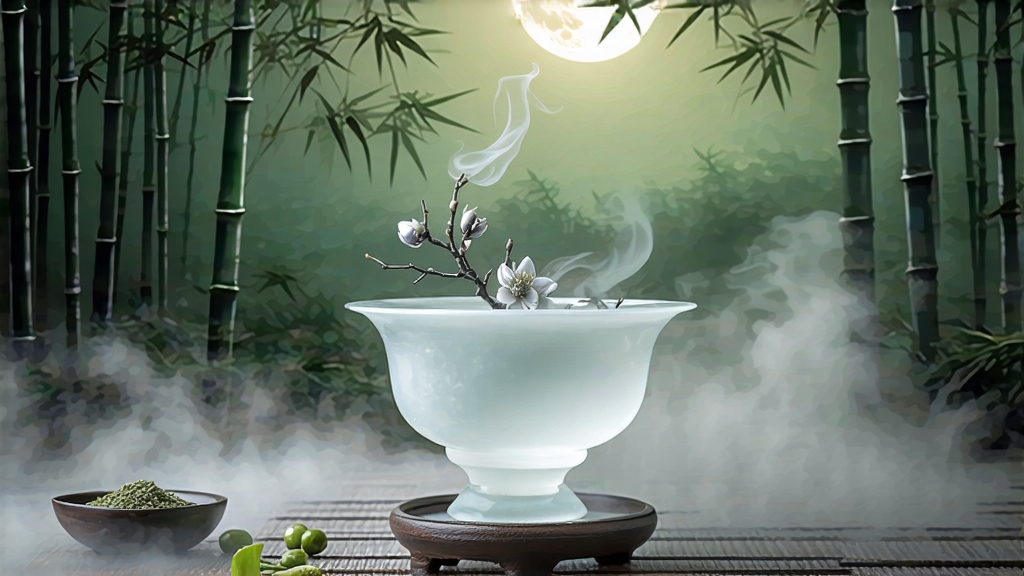
If green tea is the youthful scholar of Chinese tea and pu-erh the venerable sage, then Silver Needle—Bai Hao Yin Zhen in Mandarin—must be the quiet poet who arrives after dusk, leaving only moonlight and fragrance on the table. Revered as the aristocrat of white tea, it is harvested for only a few spring mornings each year, handled so gently that the buds seem to believe they are still on the tree. For international drinkers accustomed to bold black teas or smoky oolongs, Silver Needle offers a radically different contract: no drama of rolling, no roar of firing, only the whisper of air and time.
Historical roots
White tea’s written record begins in the Song dynasty (960-1279) when imperial tribute lists mention “white cakes” pressed from large-leaf varieties in Fujian. Yet the individual silvery bud style now called Silver Needle first appears in the late 1700s, almost certainly around Tai Lao Mountain in Fuding county. Local legend claims a tea grower noticed that buds picked just before Qingming (early April) would bleach to ivory if left in the shade of cliff-side caves. Monks at the nearby Guanyin Temple began drying the buds on bamboo trays under the full moon, believing lunar yin energy cooled the intrinsic “fire” of the leaf. Whether myth or marketing, the association with moonlight persists; even today processors schedule the final wilting phase to coincide with clear, cool nights.
Terroir and micro-seasonality
Authentic Silver Needle comes only from Fuding and, to a lesser extent, Zhenghe, two counties separated by a ridge of weathered granite. The bush itself is a small-leaf cultivar known as Fuding Da Bai Hao—“Big White Down”—whose fat spring buds can reach 3.5 cm and are sheathed in a fleece so dense it resembles hoarfrost. Bud size is critical: the thicker the trichomes, the higher the amino acid reservoir that later translates into sweet, soy-sauce-like umami. Farmers watch soil thermometers obsessively; if the average daytime temperature stays below 18 °C for five consecutive days, the plant stockpiles L-theanine instead of converting it to catechins, yielding the prized “cold-sweet” finish. Because this weather pattern is unpredictable, an entire year’s Silver Needle crop can shrink by 40 % overnight, pushing prices above those of many Dragon Well or Da Hong Pao grades.
Plucking ritual
Harvest begins at dawn when surface dew is still visible but no longer dripping; wet hands bruise the epidermis and encourage premature oxidation. Pickers use thumbnail, not fingerpads, to snap the bud cleanly above the first scale leaf. A seasoned worker gathers barely 500 g per hour—about 2,000 buds—so a kilo of finished tea represents roughly 30,000 hand-pluckings. Baskets are woven from thin bamboo slats spaced 4 mm apart, allowing any residual dew to drain so the buds arrive at the withering loft almost dry to the touch.
Crafting without craftiness
Unlike other famous teas that rely on the artisan’s split-second decision in front of a 300 °C wok, Silver Needle is made by doing almost nothing. The traditional four-step sequence is: wilting → piling → drying → resting.
- Wilting: buds are laid 2 cm deep on reed trays set in a loft whose louvered walls open toward the mountain breeze. For 36–48 hours moisture drops from 75 % to 35 %; the leaf slowly curls like a sleeping fern.
- Piling: trays are stacked for 4–6 hours so the core temperature rises to 28 °C, triggering non-enzymatic browning that tints the tip champagne-gold while the base stays silvery.
- Drying: processors divide here into “sun school” and “warm school.” Sun-school purists expose the tea to late-afternoon winter sun for 20 minutes, then move it indoors at twilight; warm-school technicians use 40 °C ovens for two hours. Aficionados claim sun-dried lots age with more layered honey notes, but controlled drying gives a cleaner, hay-like aroma.
- Resting: finished tea is held in unsealed paper cartons for ten days so residual moisture equilibrates; without this step the outer trichomes trap water that later causes off-flavors in storage.
Grading and authenticity traps
The State Standard GB/T 22291-2017 stipulates that only bud material qualifies